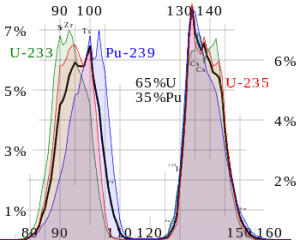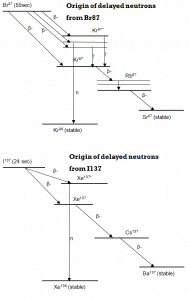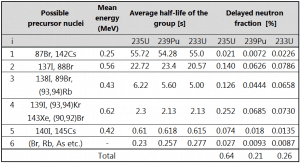Precursors of Delayed Neutrons
Delayed neutrons originate from the radioactive decay of nuclei produced in fission, and hence they are different for each fissile material. They are emitted by excited neutron-rich fission fragments (so-called the delayed neutron precursors) some appreciable time after the fission. How long afterward depends on the precursor’s half-life since the neutron emission itself occurs in a very short time. The precursors usually undergo beta decay without any neutron emission, but a small fraction of them (highly excited nuclei) can undergo the neutron emission instead of the gamma emission. In addition, current nuclear physics facilities can produce more neutron-rich isotopes that can emit multiple neutrons. Currently, about 18 2n-emitters are experimentally confirmed [IAEA – INDC(NDS)-0599], but only two of them are fission products.
As an example, the isotope 87Br is the major component of the first group of precursor nuclei. This isotope has a half-life of 55.6 seconds. It undergoes negative beta decay through its two main branches with 2.6 MeV and 8 MeV beta particles emissions. This decay leads to the formation of 87Kr* and 87Kr (ground state), and the 87Kr nucleus subsequently decays via two successive beta decays into the stable isotope 87Sr. But there is also one possible way for the 87Br nucleus to beta decay. The 87Br nucleus can beta decay into an excited state of the 87Kr nucleus at an energy of 5.5 MeV, larger than the binding energy of a neutron in the 87Kr nucleus. In this case, the 87Kr nucleus can undergo (with a probability of 2.5%) a neutron emission, leading to a stable 87Kr isotope.
According to the JEFF 3.1 database, about 240 n-emitters are known between 8He and 210Tl. About 75 of them are in the non-fission region. Furthermore, experimentally confirmed 18 2n-emitter and only four 3n-emitters ( 11Li, 14Be, 17B, 31Na). These numbers are not certainly final. Since the new IAEA Co-ordinated Research Project (CRP) on Beta-delayed neutron emission evaluation was started in 2013, it is expected these numbers will change significantly.
See also: IAEA, Beta-delayed neutron emission evaluation, INDC(NDS)-0599
As can be seen, it was identified many precursor nuclei. Not all of them are fission products (about 75 of them in the non-fission region A<70), but many precursor nuclei are in the fission region between A=70-150. Their half-lives range between tenths of second (0.12 s) and tens of seconds (55.6 s). Therefore their delayed neutrons appear with considerably differing delay times.
 Fission fragment yield for different nuclei. The most probable fragment masses are around mass 95 (Krypton) and 137 (Barium).
Fission fragment yield for different nuclei. The most probable fragment masses are around mass 95 (Krypton) and 137 (Barium).

 Delayed neutrons are traditionally represented by six delayed neutron groups, whose yields and decay constants (λ) are obtained from nonlinear least-squares fits to experimental measurements.
Delayed neutrons are traditionally represented by six delayed neutron groups, whose yields and decay constants (λ) are obtained from nonlinear least-squares fits to experimental measurements.